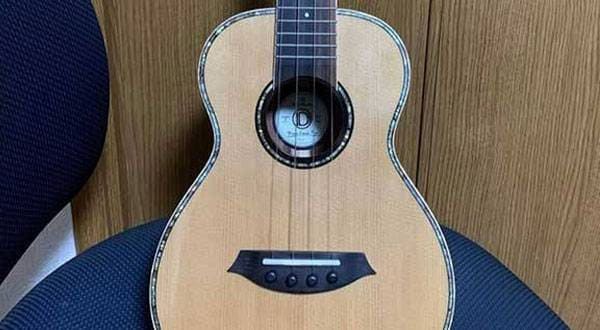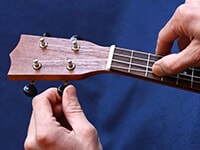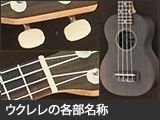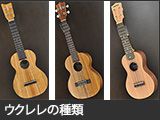Hello, Conservario here.
When it comes to playing the ukulele, there are mainly two styles:
1. Self- Accompaniment
2. Solo Ukulele
There is often debate about which is more difficult: solo ukulele or singing and playing. Some say Solo Ukulele is harder, while others argue that singing and accompanying yourself is more challenging.
You’re free to start with whichever you prefer, but if you’re feeling uncertain about which to begin with, you’re not alone.
Should you start with one over the other? Should you practice them separately? If you have these questions, this article will help clarify them for you.
■ Self-Accompaniment
This is when you play and sing at the same time.
For some reason, in Japanese it's not called "hikiutai", but “hikikatari”, which refers playing your own accompaniment while singing or reciting.
In “hikikatari”, singing is the main focus, and the ukulele serves as an accompaniment to the song.
Because of this, the parts that are played on the ukulele are naturally simple.
It’s difficult to sing while playing something too complicated, so simplicity is key.
Generally, your left hand is responsible for playing the chords, while your right hand strums or picks the strings—this is the most common way to play.
Here’s an example:

Have you ever heard of the artist Aimyon?
Aimyon is a very popular Japanese artist who always comes up when discussing singing and playing. Her songs often feature simple chord progressions and strumming patterns.
For example, the chord progression often seen in her songs is C → G → Am → Em.
For most people, except for true beginners, the challenging part of strumming and singing is "strumming while singing."
Take a good look at the strumming.
You’ll notice various combinations of down-strokes and up-strokes.
The symbol without the line beneath represents the down-stroke, and the symbol that looks like a V represents the up-stroke.
Make sure to follow the markings as they are written.
If you try to play without following the down-stroke and up-stroke, the rhythm can easily become messy.
For more advanced players, it might not matter how they play, but for those who are not yet accustomed to strumming and singing, it’s important to stick to the proper down-stroke and up-stroke.
You need to get comfortable with both the right hand (strumming) and left hand (chords) first before adding the singing. However, this is where the difficulty level increases significantly.
Depending on the music genre, the rhythm of the lyrics and the strumming pattern often need to be completely different, so it can be a challenge to coordinate them.
Do you know the song "Kaeru no Uta" (The Frog Song)?
"Kaeru no Uta" is a song where both the lyrics and the right-hand strumming can be played together in the same rhythm.
You sing "Ka-e-ru-no-u-ta-ga" while strumming "ta-ta-ta-ta-ta-ta-ta-ta-" (8 times).
However, this is quite a special case.
Most J-POP, Hawaiian music, rock, and jazz can't be played with such a simple rhythm.
So, the trick is to perfect both the ukulele playing and the singing before trying to play them together.
There are no shortcuts, so let's work steadily and do our best!
■ Solo Ukulele
This refers to music that is played on just the ukulele.
You play both the melody and chords at the same time. It might sound impossible, but it’s absolutely doable.
However, the movements of both your left and right hands become more intricate compared to when you’re singing and playing at the same time.
Here’s an example.

Twinkle Twinkle Little Star is simplified here.
Due to the ukulele tuning, many versions are written in the key of G, but this music sheet is in the key of C.
When performing a singing and playing version, you strum all the strings. However, in solo ukulele, the number of strings you play is specified in detail.
For example, the first two notes are played only on the 4th and 3rd strings.
Since the 3rd string is the main melody, it’s important not to let the 2nd or 1st strings ring out.
In solo ukulele, you need to distinguish between playing the melody and the chords, so if you strum randomly, it won’t sound like music.
Pay attention to the tablature and make sure that while you press the frets, you’re also aware of which strings (and how many) to pluck with your right hand.
When plucking 2 or 3 strings with your right hand, there are several ways to do it.
Let’s consider the case of plucking the open 4th and 3rd strings.
① Play 2 strings with your thumb: This technique involves using the thumb to strum both the 4th and 3rd strings downward, as if gently stroking them. You stop at the 2nd string, letting only the 4th and 3rd strings ring out.
① Play 2 Strings with your index finger and thumb: In this technique, the thumb strums downward, while the index finger strums upward, both plucking the 4th and 3rd strings at the same time.
Since you need to use different chord forms and right-hand techniques compared to strumming while singing, it may be challenging at first.
However, practicing solo ukulele will expand your variety of playing techniques for both the right and left hands. So, be sure to give it a try and practice these methods!
To Summarize
We’ve covered the features and practice methods for both singing and playing and solo ukulele. While I’ve introduced them separately in this article, these two ways of playing are not entirely different from each other. They share many similarities, and there are also many songs that combine elements of both styles.
In fact, many solo ukulele songs use the same chord shapes as strumming songs. So, there’s no need to worry that practicing one too much will make you worse at the other. Feel free to practice whichever style interests you first!
Ultimately, learning and becoming comfortable with both styles is the best approach.
Thank you for reading until the end!
→ Check out the ukulele selection on SOUND HOUSE
The “sound & person” column is made up of contributions from you.
For details about contributing, click here.











![[Enjoy the Ukulele Even More!] Basic Knowledge Before You Start Playing](/contents/uploads/thumbs/5/2022/2/20220214_5_16700_1.jpg)

![[Enjoy the Ukulele Even More!] For Those Who Don’t Have Time to Practice](/contents/uploads/thumbs/5/2022/2/20220210_5_16650_1.jpg)
![[Enjoy the Ukulele Even More!] Practice that You Can Do Even Without Your Ukulele](/contents/uploads/thumbs/5/2022/1/20220131_5_16448_1.jpg)
![[Enjoy the Ukulele Even More!] How to Apply Vibrato](/contents/uploads/thumbs/5/2022/1/20220131_5_16451_1.jpg)
![[Enjoy the Ukulele Even More!] Self-Accompaniment and Solo Ukulele](/contents/uploads/thumbs/5/2022/1/20220128_5_16395_1.jpg)
 ウクレレのチューニング方法
ウクレレのチューニング方法
 ウクレレの各部名称
ウクレレの各部名称
 ウクレレの種類
ウクレレの種類
 ウクレレスタートガイド
ウクレレスタートガイド
 めちゃラク!ギター講座
めちゃラク!ギター講座
 ウクレレ初心者講座
ウクレレ初心者講座















